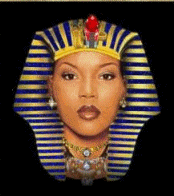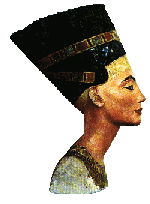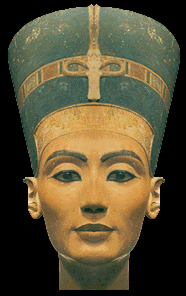| Daily Life |
Pharaohs
| Queen Hatshepsut |  |
Tutankhamun |
| Queen Nefertiti | ||
| Rameses II | ||
| Egyptian Government | Crowns of Egypt | Egyptian Time Line |
Egyptian Government
The State (government) controlled foreign trade and received all the revenue which, together with tributes from conquered lands and income from local taxes, made Egypt the wealthiest country in the ancient world.
The king held a crook and flail - symbols of power linking him to the god Osiris. He also wore a crown and a false beard.
|
|
|
People expected pharaohs to be physically strong, expert at hunting and able to lead the army to victory in battle. Their subjects thought the god-kings controlled the flowing and flooding of the Nile and the growth of crops, as well as the country's success in foreign trade. Everyone knelt and kissed the ground when they approached a royal person. The pharaohs continued to be worshipped even after they had died and joined the god Osiris in the kingdom of the dead.
The Pharaoh's people expected him to make sure that:
the Nile flooded as required
there was enough food for people to eat
the gods looked kindly on the people
Egypt's army could defend it against any enemies
truth, or ma'at, was at the heart of Egyptian life
![]()
Queen Hatshepsut
Pharaoh's wives were also regarded as gods and shared their husband's wealth. Women rarely ruled the country unless it was for a short time at the end of a dynasty when there were no men to take over. Hatshepsut was the only strong female ruler of that dynasty.
When Queen Hatshepsut's husband died, she took control of the government and ruled for her stepson Tuthmosis III, who was only five. Hatshepsut was the first female pharaoh who held power for about 20 years. This was the longest reign for a female pharaoh. Statues show her wearing the false beard of kingship.
DID YOU KNOW: The women in Egypt carried the royal blood, not the men. To become pharaoh, the man had to marry a female of royal blood, often a sister, half sister or other near relative, usually it was the eldest daughter of the previous pharaoh.

![]()
Queen Nefertiti


This painted limestone bust of Queen Nefertiti shows her wearing a crown and necklace rich with jewels. Nefertiti was the wife of Akhenaten. She helped him establish a new city at Amarna on the east bank of the River Nile in Middle Egypt.
![]()
Crowns of Egypt

| RED CROWN | WHITE CROWN | DOUBLE CROWN | ATEF CROWN | CEREMONIAL ATEF CROWN | BLUE CROWN |
The Red Crown
This red crown was associated with Lower Egypt - the area from Memphis northwards around the Nile Delta.
The White Crown
This is the crown of Upper Egypt, which stretched from Memphis southwards to Thebes and beyond.
The Double Crown
As king of both Upper and Lower Egypt the Pharaoh wore a Double Crown made up of the White Crown of Upper Egypt and the Red Crown of Lower Egypt.
The Atef Crown
A crown topped with two large feathers, which was one of the symbols of the Egyptian god Osiris.
The Blue Crown
This is known as the "war" crown because scenes of Seti I and his son Ramses II show them wearing it in battle.
| Daily Life |